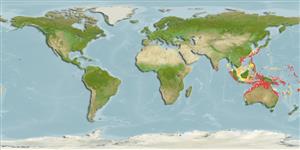Common names from other countries
>
Gobiiformes (Gobies) >
Gobiidae (Gobies) > Gobiinae
Etymology: Lubricogobius: Latin, lubricus = slipperiness, smoothness + Latin, gobius = gudgeon (Ref. 45335).
Environment: milieu / climate zone / depth range / distribution range
นิเวศวิทยา
เกี่ยวกับทะเล,น้ำเค็ม สัตว์น้ำหน้าดิน; ระดับความลึก 17 - 79 m (Ref. 45340). Subtropical
การแพร่กระจาย
ประเทศต่างๆ | พื้นที่จำแนกตาม FAO | ระบบนิเวศหลายระบบ | การปรากฏขึ้น,การเกิดขึ้น,พบ | Point map | การแนะนำ | Faunafri
Indo-West Pacific: Japan (Ryukyu Islands), Vietnam, Indonesia (northern Sulawesi), Australia (Western Australia to Queensland) and New Caledonia.
ขนาด / น้ำหนัก / Age
Maturity: Lm ? range ? - ? cm
Max length : 3.4 cm SL เพศผู้/กระเทย; (Ref. 45340)
Short description
เครื่องมือที่ใช้ในการแยกชนิดสัตว์,สิ่งมีชีวิตออกจากกัน | สัณฐานวิทยา | ความยาวต่างๆ
เงี่ยงครีบหลัง (รวม) : 7; ก้านครีบอ่อนที่หาง (รวม) : 8 - 10; เงี่ยงครีบก้น: 1; ก้านครีบอ่อนที่ก้น: 6 - 7. Anterior nostrils present; dorsal and ventral edges of caudal peduncle not keeled; orange with pale blue lines radiating from eye and one descending from nape, bifurcating onto preopercular margin and opercle (Ref. 45340). Caudal fin rounded (Ref. 45340); further characterized by having united pelvic fins with well-developed frenum; absence of scales on head or body; no sensory pores on head, prominent papillae; depth of body 2.9-3.9 in SL (Ref. 90102).
Inhabits sand, silt, and rubble bottoms, takes refuge in dead shells, worn tubes, tunicates and empty bottles (Ref. 90102).
Life cycle and mating behavior
Maturities | การสืบพันธุ์ | Spawnings | Egg(s) | Fecundities | ตัวอ่อน
Randall, J.E. and H. Senou, 2001. Review of the Indo-Pacific gobiid fish genus Lubricogobius, with description of a new species and a new genus for L. pumilus. Ichthyol. Res. 48(1):3-12. (Ref. 45340)
IUCN Red List Status (Ref. 130435)
CITES (Ref. 128078)
Not Evaluated
Threat to humans
Harmless
Human uses
เครื่องมือ
Special reports
Download XML
แหล่งที่มาจากอินเตอร์เน็ต
Estimates based on models
Preferred temperature (Ref.
115969): 23.6 - 28.5, mean 27.2 (based on 219 cells).
Phylogenetic diversity index (Ref.
82804): PD
50 = 0.5156 [Uniqueness, from 0.5 = low to 2.0 = high].
Bayesian length-weight: a=0.01023 (0.00477 - 0.02194), b=3.02 (2.84 - 3.20), in cm Total Length, based on LWR estimates for this (Sub)family-body shape (Ref.
93245).
ระดับชั้นอาหาร (Ref.
69278): 3.1 ±0.3 se; based on size and trophs of closest relatives
ความสามารถในการกลับคืนสู่ปกติ (Ref.
120179): ความสูง, เวลาต่ำสุดที่จะทำให้ประชากรเพิ่มขึ้นเป็น 2 เท่าใช้เวลาน้อยกว่า 15 เดือน (Preliminary K or Fecundity.).
Fishing Vulnerability (Ref.
59153): Low vulnerability (10 of 100).
